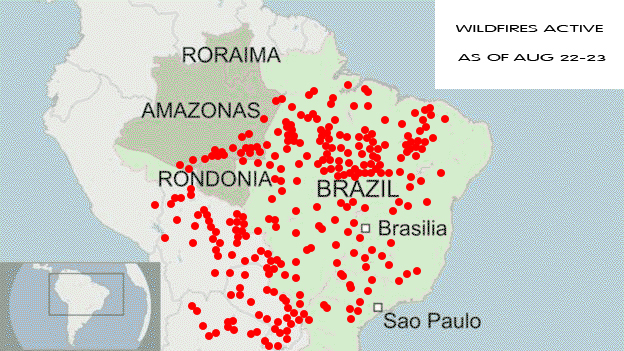Amazon Rainforest Aftermath
Looking at the effect the Amazon rainforest has on the environment
Depicted above is a map of all the fires that took place in the Amazon rainforest on Aug 22-23
A thick black smoke laid across the shimmering green foliage, while the bright fire flickered and slowly engulfed both the ground and the sky around it, making a wall of red that would be the only thing seen from miles around. This was no regular forest fire; this was something much bigger. This was the Amazon Rainforest on fire, the “Lungs of the World” was now in flames.
In August, the world watched in shock as they witnessed that the Amazon Rainforest was on fire. Though fires in the Amazon have always happened, Brazil’s Satellite Agency stated that there had been an 85% increase compared to August 2018. The agency depicted that more than 74,000 fires had taken place between January and August. Many researchers believe that the fires were both natural and human-caused due to it being a dry season.
“Many don’t realize while they cultivate land to grow their own crops, they are affecting that habitat.” biology teacher Linnea Homa said.
The man-made fires are believed to be most likely caused by small groups of local people trying to clear out land for farming. This is believed to be as a result of the new President Bolsonaro’s ideals on deforestation and agriculture.
“The Amazon forest holds something like 90 billion tons of carbon, and if that ends up in the atmosphere it’s not a good thing,” professor of Environmental Science at George Mason University Thomas Lovejoy said.
A large concern that many around the world share is worrying about what the effect will end up being on the world as a whole. One of the more concerning parts of the fire taking place in the Amazon rainforest is the effect that it could have on South America. Due to the amount of smoke being released, the amount of rainfall will most likely be reduced, resulting in more dry weather, which could result in more wildfires.
While the Amazon Rainforest does help regulate the carbon levels on the Earth, it makes up less than 10% of the earth’s overall oxygen, so it’s hard to determine just what effect on the planet, as a whole this fire will have. This does not mean that the Amazon rainforest isn’t important for other reasons.
Many do not realize exactly what is grown and found in the Amazon rainforest. For example, many medicines in the world use plant roots that are found in the rainforest, such as Quinine, Tubocurarine, Vincristine and Vinblastine. Quinine was one of the first effective medicines used to treat Malaria and Tubocurarine was also used as anesthesia. Lastly, Vincristine and Vinblastine were both found to help stop the growth of cancer cells, which has helped increase the chance of surviving childhood leukemia drastically.
“This may not have a direct effect on us, but I think it does raise a concern to the fires that take place in our country,” Homa said.
Not only does the rainforest offer different tropical plants, but it is also home to hundreds of species of animals, reptiles, insects and Brazil’s indigenous people.



